The Effect of Refined Coherent Grain Boundaries on High-Temperature Oxidation Behavior of TiAl-Based Alloys through Cyclic Heat Treatment
Abstract
1. Introduction
2. Materials and Methods
3. Results
3.1. Microstructure of CFL and FFL Alloys
3.2. Isothermal Oxidation Behaviors
3.3. Microstructure of Surface and Cross-Section after Oxidation
4. Discussion
5. Conclusions
- (1)
- The CFL (~400 μm) TiAl alloy can be refined to 40 μm through metastable γ structures by cyclic heat treatment. After oxidation tests at 1000 °C for 100 h, the lowest mass gain is 3.09 mg/cm2 of the FFL alloy, which is 31.6% lower than the CFL alloy.
- (2)
- Two kinds of variant selection processes: the coherent metastable γ variants of 120° rotational interface precipitated during the air-cooling process to form a Type II coherent boundary, as well as αs variants originated from one metastable γ variant during holding at the single α phase region process, could promote the formation of Type I coherent boundaries of FFL alloy.
- (3)
- Coherent grain boundaries can reduce oxidation diffusion toward the substrate. Additionally, heavy elements of Nb and Ta are uniformly distributed during the diffusion process instead of being segregated at disordered grain boundaries. This promotes the formation of a continuous protective barrier consisting of (Ti, (Nb, Ta))O2, TiN, and Al(Nb,Ta)2 layers.
Author Contributions
Funding
Data Availability Statement
Conflicts of Interest
References
- Chen, G.; Peng, Y.; Zheng, G.; Qi, Z.; Wang, M.; Yu, H.; Dong, C.; Liu, C.T. Polysynthetic twinned TiAl single crystals for high temperature applications. Nat. Mater. 2016, 14, 876–881. [Google Scholar] [CrossRef] [PubMed]
- Kim, J.Y.; Park, E.S.; Lee, T.; Ryu, S.; Kim, S.E.; Kim, S.W. Origin of enhanced room temperature ductility in TiAl alloys: Reducing activation difference of deformation mechanism of γ phase. J. Alloys. Compd. 2022, 899, 163307. [Google Scholar] [CrossRef]
- Fang, H.; Wang, S.; Chen, R.; Xu, Q.; Yan, Y.; Su, Y.; Guo, J. The effects of the formation of a multi-scale reinforcing phase on the microstructure evolution and mechanical properties of a Ti2AlC/TiAl alloy. Nanoscale 2021, 13, 12565. [Google Scholar] [CrossRef] [PubMed]
- Sun, T.; Guo, Z.; Cao, J.; Liang, Y.; Lin, J. Isothermal oxidation behavior of high-Nb-containing TiAl alloys doped with W, B, Y, and C/Si. Corros. Sci. 2023, 213, 110980. [Google Scholar] [CrossRef]
- Pflumm, R.; Donchev, A.; Mayer, S.; Clemens, H.; Schütze, M. High-temperature oxidation behavior of multi-phase Mo-containing γ-TiAl-based alloys. Intermetallics 2014, 53, 45–55. [Google Scholar] [CrossRef]
- Mitoraj, M.; Godlewska, E.M. Oxidation of Ti-46Al-8Ta in air at 700 °C and 800 °C under thermal cycling conditions. Intermetallics 2013, 34, 112–121. [Google Scholar] [CrossRef]
- Swadźba, R.; Marugib, K.; Pyclik, Ł. STEM investigations of γ-TiAl produced by additive manufacturing after isothermal oxidation. Corros. Sci. 2020, 169, 108617. [Google Scholar] [CrossRef]
- Yu, P.; Xin, L.; Muhammad, D.H.; Yang, F.; Liu, C.; Li, Y.; Li, X.; Xu, W.; Qu, X.; Cao, P. Effect of Sn addition on the high-temperature oxidation behavior of high Nb-containing TiAl alloys. Corros. Sci. 2020, 166, 108449. [Google Scholar]
- Tian, S.; He, A.; Liu, J.; Zhang, Y.; Yang, Y.; Zhang, Y.; Jiang, H. Oxidation resistance of TiAl alloy improved by hot-pack rolling and cyclic heat treatment. Mater. Charact. 2021, 178, 111196. [Google Scholar]
- Liang, Z.; Xiao, S.; Yue, H.; Li, X.; Li, Q.; Zheng, Y.; Xu, L.; Xue, X.; Tian, J.; Chen, Y. Tailoring microstructure and improving oxidation resistance of an additively manufactured high Nb containing TiAl alloy via heat treatment. Corros. Sci. 2023, 220, 111287. [Google Scholar] [CrossRef]
- Narayana, P.L.; Kima, J.H.; Yun, D.W.; Kim, S.E.; Reddy, N.S.; Yeom, J.T.; Seo, D.; Hong, J.K. High temperature isothermal oxidation behavior of electron beam melted multi-phase γ-TiAl alloy. Intermetallics 2022, 141, 107424. [Google Scholar] [CrossRef]
- Garip, Y. Investigation of isothermal oxidation performance of TiAl alloys sintered by different processing methods. Intermetallics 2020, 127, 106985. [Google Scholar] [CrossRef]
- Zhang, K.R.; Hu, R.; Lei, T.C.; Yang, J.R. Refinement of massive γ phase with enhanced properties in a Ta containing γ-TiAl-based alloys. Scripta Mater. 2019, 172, 113–118. [Google Scholar] [CrossRef]
- Hu, R.; Wu, Y.; Yang, J.; Gao, Z.; Li, J. Phase transformation pathway and microstructural refinement by feathery transformation of Ru-containing γ-TiAl alloy. J. Mater. Res. Technol. 2022, 18, 5290–5300. [Google Scholar] [CrossRef]
- Wei, D.X.; Koizumi, Y.; Nagasako, M.; Chiba, A. Refinement of lamellar structures in Ti-Al alloy. Acta Mater. 2017, 125, 81–97. [Google Scholar] [CrossRef]
- Zhang, K.R.; Hu, R.; Li, J.; Yang, J.; Gao, Z. Grain refinement of 1 at.% Ta-containing cast TiAl-based alloy by cyclic air-cooling heat treatment. Mater. Lett. 2020, 274, 127940. [Google Scholar] [CrossRef]
- Yim, S.; Bian, H.; Aoyagi, K.; Chiba, A. Effect of multi-stage heat treatment on mechanical properties and microstructure transformation of Ti–48Al–2Cr–2Nb alloy. Mat. Sci. Eng. A 2021, 816, 141321. [Google Scholar] [CrossRef]
- Chepak-Gizbrekh, M.V.; Knyazeva, A.G. Oxidation of TiAl alloy by oxygen grain boundary diffusion. Intermetallics 2023, 162, 107993. [Google Scholar] [CrossRef]
- Liu, Y.; Hu, R.; Kou, H.; Zhang, T.; Wang, J.; Li, J. A mixture of massive and feathery microstructures of Ti48Al2Cr2Nb alloy by high undercooled solidification. Mater. Charact. 2015, 100, 104–107. [Google Scholar] [CrossRef]
- Dey, S.R.; Bouzy, E.; Hazotte, A. Features of feathery γ structure in a near-γ TiAl alloy. Acta Mater. 2008, 56, 2051–2062. [Google Scholar] [CrossRef]
- Lapin, J.; Marek, K. Effect of continuous cooling on solid phase transformations in TiAl-based alloy during Jominy end-quench test. J. Alloys Compd. 2018, 735, 338–348. [Google Scholar] [CrossRef]
- Saage, H.; Huang, A.J.; Hu, D.; Loretto, M.H.; Wu, X. Microstructures and tensile properties of massively transformed and aged Ti46Al8Nb and Ti46Al8Ta alloys. Intermetallics 2009, 17, 32–38. [Google Scholar] [CrossRef]
- Gao, Z.; Hu, R.; Zou, H.; Li, J.; Zhou, M.; Luo, X. Metastable microstructure evolution and grain refinement in a Low-Ta containing γ-TiAl alloy through heat treatment. J. Mater. Res. Technol. 2024, 29, 3642–3655. [Google Scholar] [CrossRef]
- Xu, Y.X.; Lu, J.T.; Yang, X.W.; Yan, J.B.; Li, W.Y. Effect and role of alloyed Nb on the air oxidation behaviour of Ni-Cr-Fe alloys at 1000 °C. Corros. Sci. 2017, 127, 10–20. [Google Scholar] [CrossRef]
- Jie, L.; Xiangyi, X. Isothermal oxidation behavior of TiAl-Nb-W-B-Y alloys with different lamellar colony sizes. Rare Met. Mater. Eng. 2016, 45, 1695–1699. [Google Scholar] [CrossRef]
- Pilone, D.; Felli, F. Isothermal oxidation behaviour of TiAl-Cr-Nb-B alloys produced by induction melting. Intermetallics 2012, 26, 36–39. [Google Scholar] [CrossRef]
- Gui, W.; Liang, Y.; Qin, J.; Wang, Y.; Lin, J. Fluorine Effect for Improving Oxidation Resistance of Ti-45Al-8.5Nb Alloy at 1000 °C. Materials 2022, 15, 2767. [Google Scholar] [CrossRef]
- Dadéa, M.; Esin, V.A.; Nazéa, L.; Sallot, P. Short- and long-term oxidation behaviour of an advanced Ti2AlNb alloy. Corros. Sci. 2019, 148, 379–387. [Google Scholar] [CrossRef]
- Gao, Z.; Hu, R.; Zou, H.; Zhou, M.; Luo, X. Insight into the Ta alloying effects on the oxidation behavior and mechanism of cast TiAl alloy. Mater. Design 2024, 241, 112941. [Google Scholar] [CrossRef]
- Zatsepin, D.A.; Boukhvalov, D.W.; Kurmaev, E.Z.; Zhidkov, I.S.; Kim, S.S.; Cui, L.; Gavrilov, N.V.; Cholakh, S.O. XPS and DFT study of Sn incorporation into ZnO and TiO2 host matrices by pulsed ion implantation. Phys. Status Solidi 2015, 252, 1890–1896. [Google Scholar] [CrossRef]
- Dai, J.J.; Zhu, J.Y.; Chen, C.Z.; Weng, F. High temperature oxidation behavior and research status of modifications on improving high temperature oxidation resistance of titanium alloys and titanium aluminides: A review. J. Alloys Compd. 2016, 685, 784–798. [Google Scholar] [CrossRef]
- Quadakkers, W.J.; Schaaf, P.; Zheng, N.; Gil, A.; Wallura, E. Beneficial and detrimental effects of nitrogen on the oxidation behaviour of TiAl-based intermetallics. Mater. Corros. 1997, 48, 28–34. [Google Scholar]
- Wang, S.; Zhang, Y.; Qin, Y.; Lu, J.; Liu, W. Improvement of TiN coating on comprehensive performance of NiTi alloy braided vascular stent. Ceram. Int. 2023, 49, 13405–13413. [Google Scholar] [CrossRef]
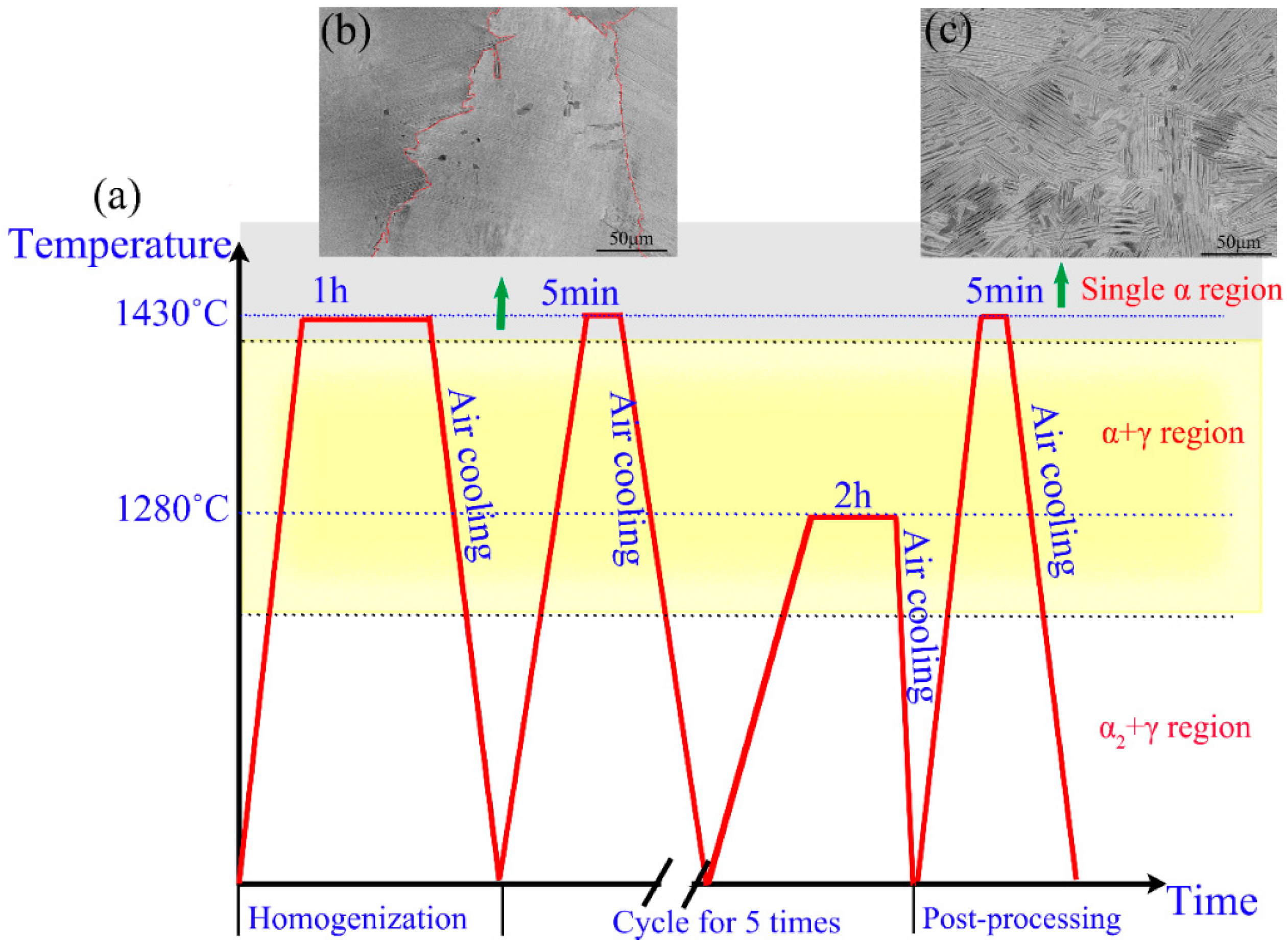
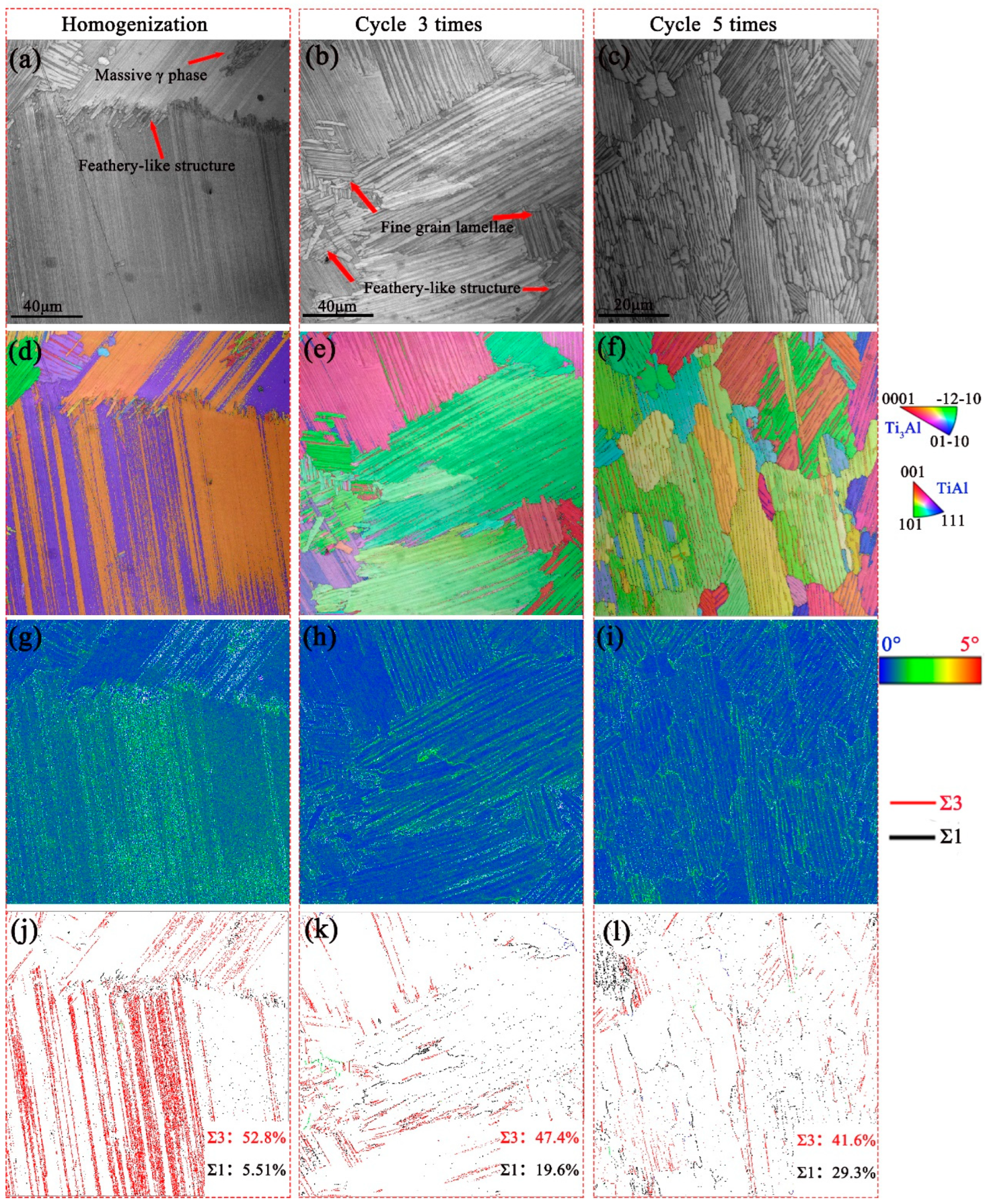


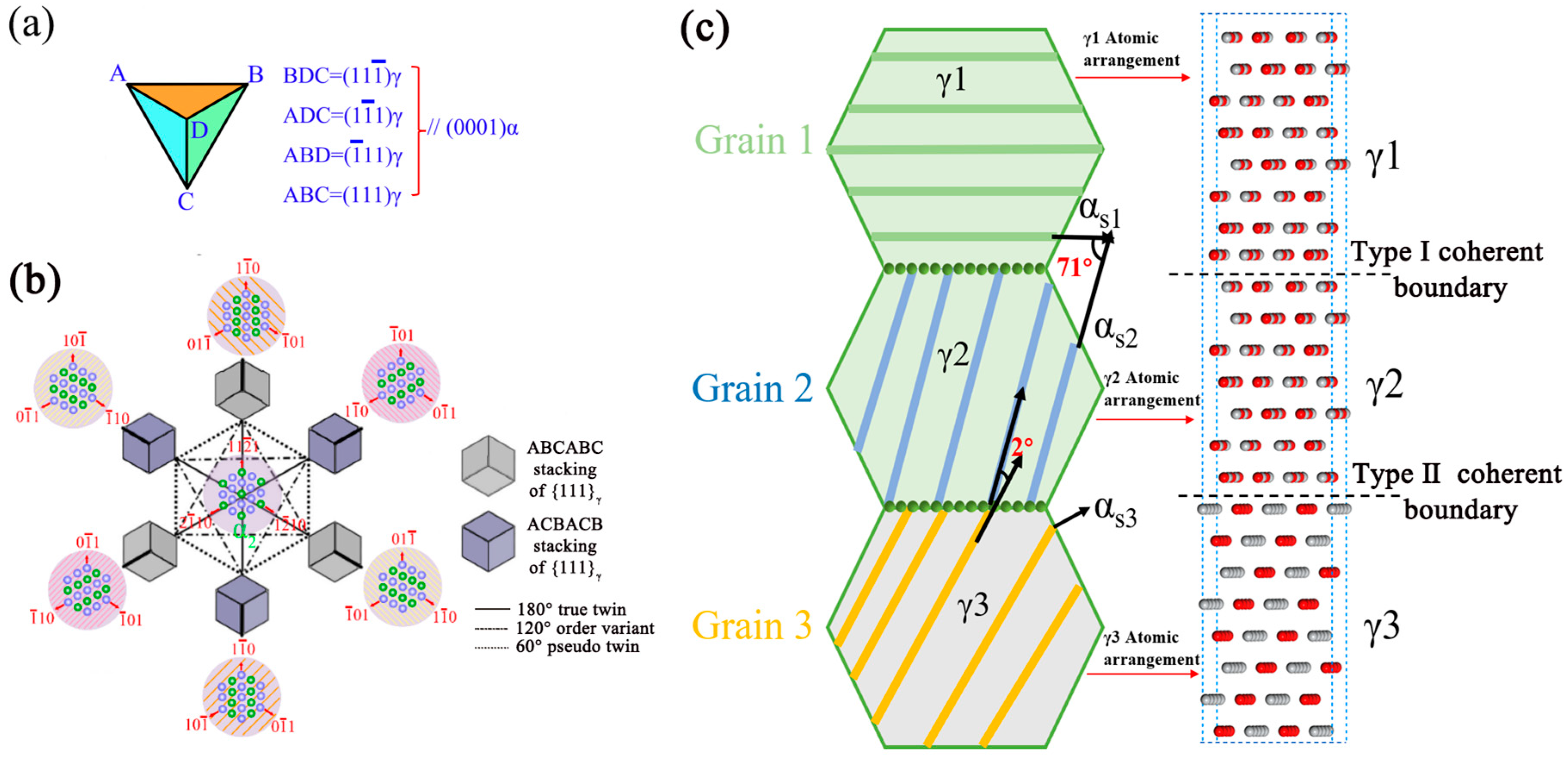
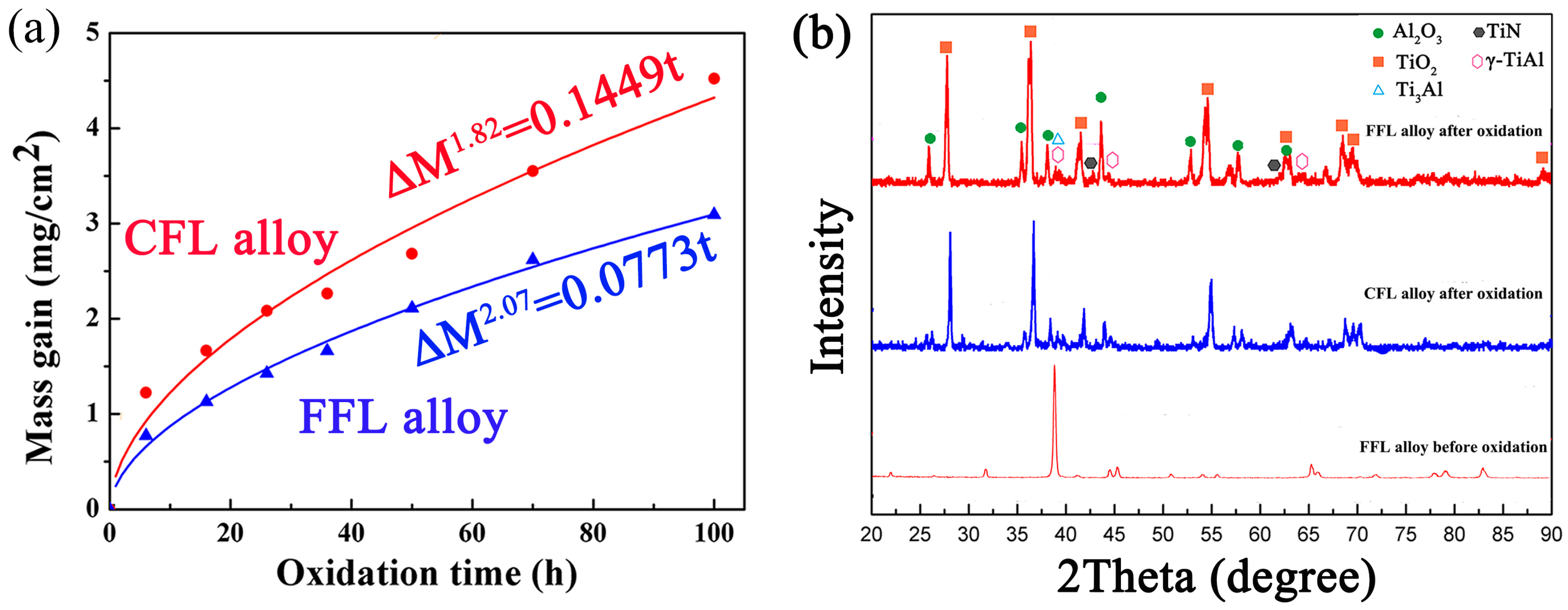
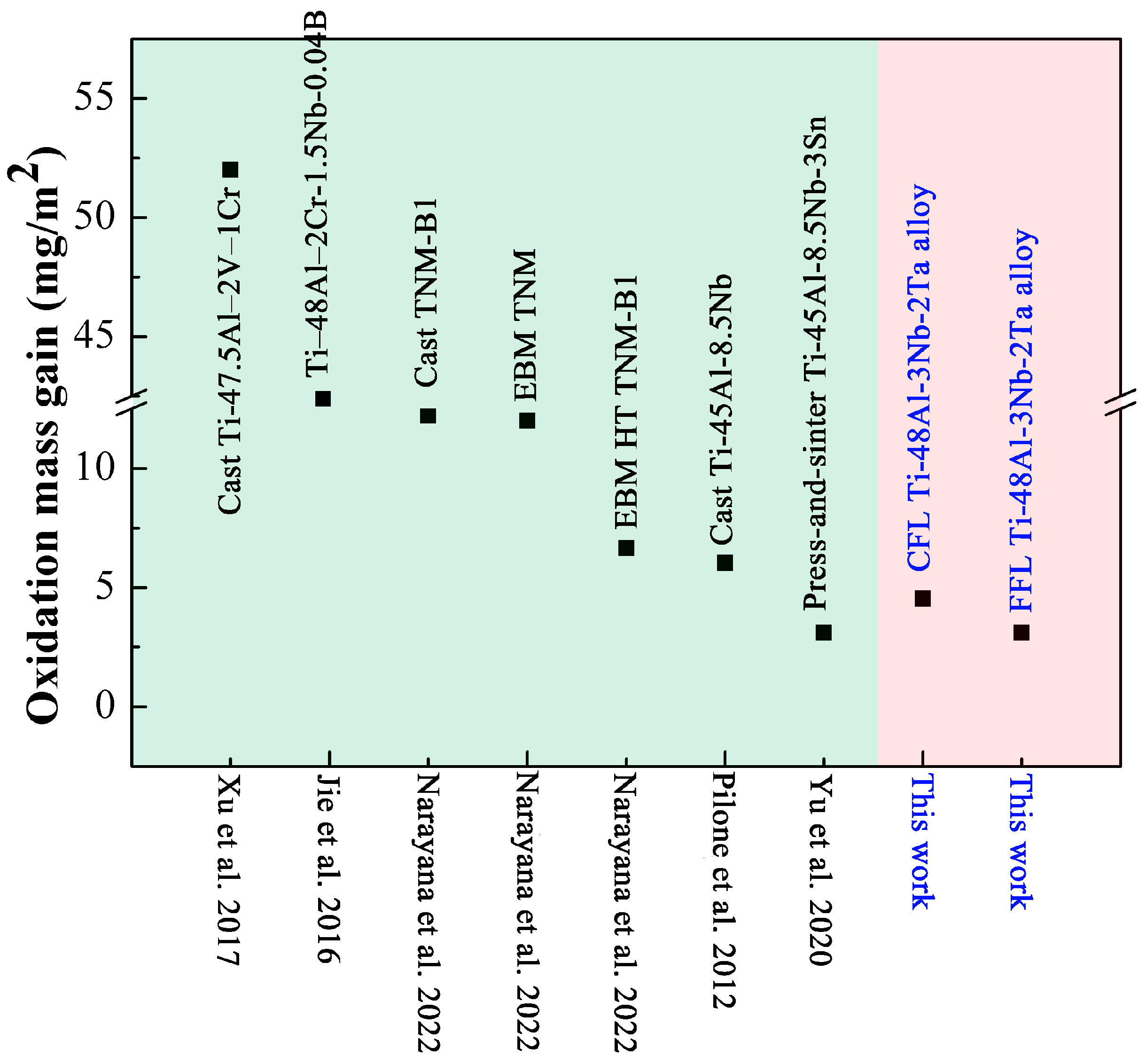




| Site | Element Composition (wt.%) | Corresponding Oxide | |||||
|---|---|---|---|---|---|---|---|
| Ti | Al | Nb | Ta | O | N | ||
| 1 | 47.66 | 10.52 | 3.07 | 1.89 | 33.27 | 3.59 | TiO2 |
| 2 | 19.21 | 41.17 | 2.27 | 1.21 | 36.14 | 0 | Al2O3 |
| 3 | 38 | 14.6 | 1.4 | 1.2 | 34.6 | 10.2 | TiN |
| 4 | 21.35 | 42.22 | 18.13 | 7.06 | 4.97 | 6.27 | Al(Nb, Ta)2 |
| 5 | 50.34 | 13.23 | 8.47 | 3.81 | 20.92 | 3.23 | TiO2 |
| 6 | 50.07 | 27.32 | 1.67 | 1.3 | 8.55 | 11.09 | TiN |
| 7 | 24.76 | 44.6 | 15.28 | 6.35 | 5.63 | 3.38 | Al(Nb, Ta)2 |
Disclaimer/Publisher’s Note: The statements, opinions and data contained in all publications are solely those of the individual author(s) and contributor(s) and not of MDPI and/or the editor(s). MDPI and/or the editor(s) disclaim responsibility for any injury to people or property resulting from any ideas, methods, instructions or products referred to in the content. |
© 2024 by the authors. Licensee MDPI, Basel, Switzerland. This article is an open access article distributed under the terms and conditions of the Creative Commons Attribution (CC BY) license (https://creativecommons.org/licenses/by/4.0/).
Share and Cite
Zhang, K.; Zhang, L.; Li, J. The Effect of Refined Coherent Grain Boundaries on High-Temperature Oxidation Behavior of TiAl-Based Alloys through Cyclic Heat Treatment. Metals 2024, 14, 521. https://doi.org/10.3390/met14050521
Zhang K, Zhang L, Li J. The Effect of Refined Coherent Grain Boundaries on High-Temperature Oxidation Behavior of TiAl-Based Alloys through Cyclic Heat Treatment. Metals. 2024; 14(5):521. https://doi.org/10.3390/met14050521
Chicago/Turabian StyleZhang, Keren, Lele Zhang, and Jinguang Li. 2024. "The Effect of Refined Coherent Grain Boundaries on High-Temperature Oxidation Behavior of TiAl-Based Alloys through Cyclic Heat Treatment" Metals 14, no. 5: 521. https://doi.org/10.3390/met14050521
APA StyleZhang, K., Zhang, L., & Li, J. (2024). The Effect of Refined Coherent Grain Boundaries on High-Temperature Oxidation Behavior of TiAl-Based Alloys through Cyclic Heat Treatment. Metals, 14(5), 521. https://doi.org/10.3390/met14050521





